Business Innovation: Leveraging Open Data for Competitive Advantage
VerifiedAdded on 2020/03/23
|17
|2556
|69
Report
AI Summary
This report investigates the impact of open data on business innovation. It begins with an introduction outlining the project's objectives, which are to assess the role and benefits of open data in fostering innovation and identify associated risks. The project's scope is defined, emphasizing the potential of open data to enhance business performance and innovation. A literature review explores the concept of innovation, its importance in business, and the benefits of open data, including increased efficiency, economic growth, and social welfare. The report poses key research questions, such as how open data can be used for innovation and the challenges involved. It details the qualitative and quantitative research methodologies, including sampling, data collection, and analysis techniques. The report acknowledges research limitations, such as time and budget constraints. A time schedule outlines the project's activities, from defining objectives to completing the literature review and research methodology. The conclusion emphasizes the significance of open data in business innovation, highlighting its potential to drive creative solutions and competitive advantages. References are provided to support the research findings.
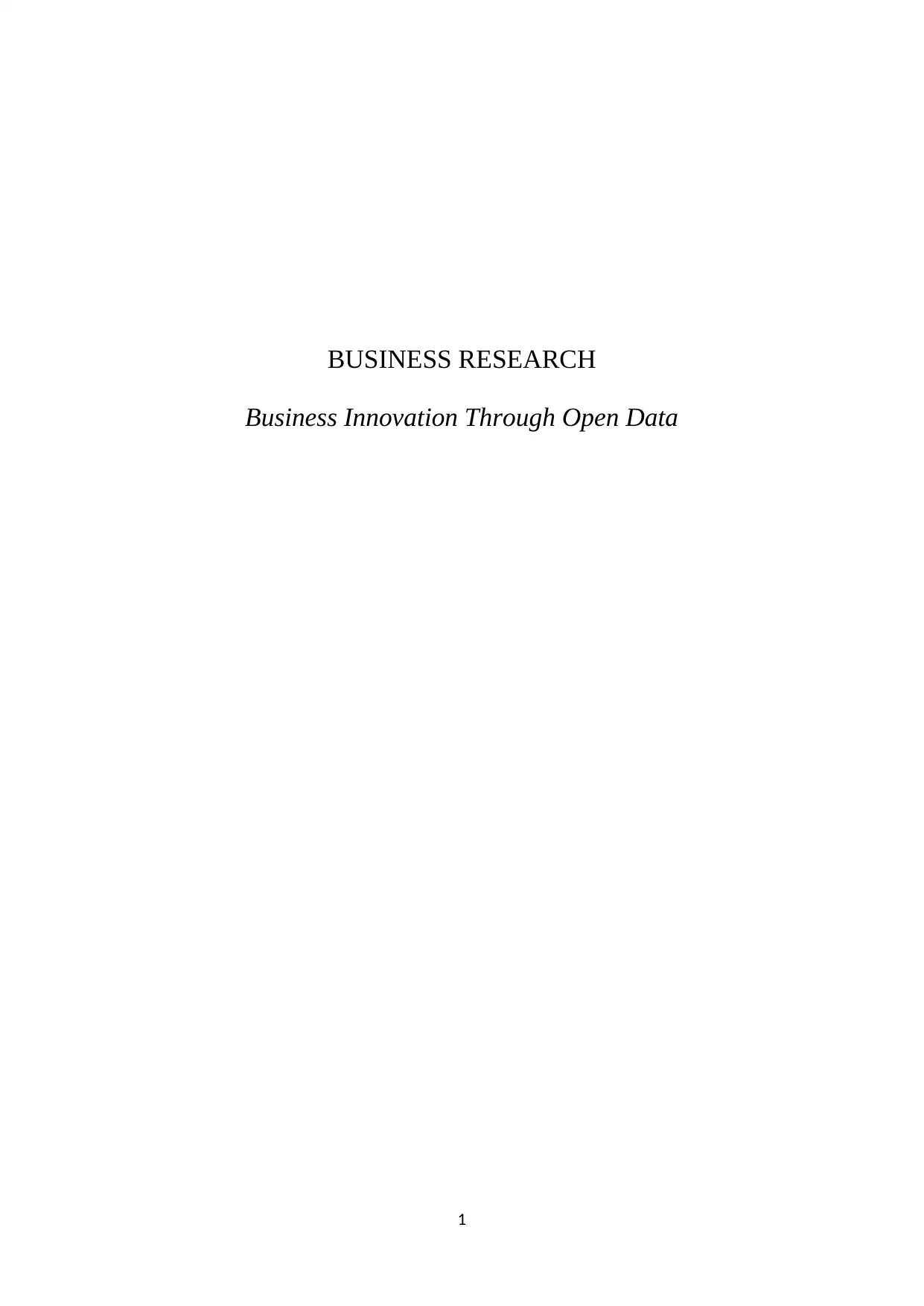
BUSINESS RESEARCH
Business Innovation Through Open Data
1
Business Innovation Through Open Data
1
Paraphrase This Document
Need a fresh take? Get an instant paraphrase of this document with our AI Paraphraser
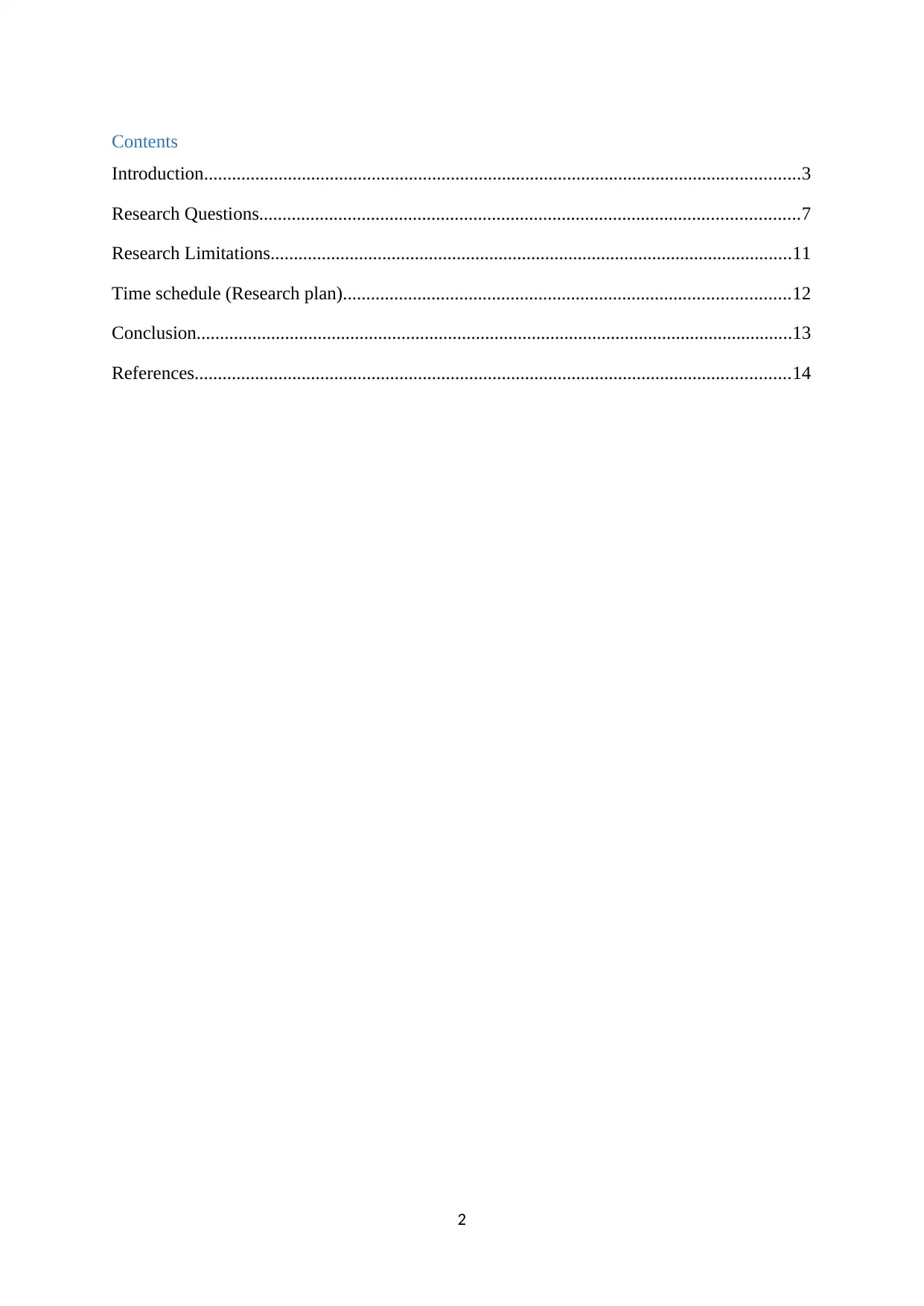
Contents
Introduction................................................................................................................................3
Research Questions....................................................................................................................7
Research Limitations................................................................................................................11
Time schedule (Research plan)................................................................................................12
Conclusion................................................................................................................................13
References................................................................................................................................14
2
Introduction................................................................................................................................3
Research Questions....................................................................................................................7
Research Limitations................................................................................................................11
Time schedule (Research plan)................................................................................................12
Conclusion................................................................................................................................13
References................................................................................................................................14
2

Introduction
This project study the role of open data in business innovation. As open data can be used by
the business organizations for a different purpose. Through using open data benefits can be
availed by the business organizations. This project comprehends the objective and scope of
the project; conceptual framework i.e. literature review in context to open data and business
innovation; important research question; methodology for the research; limitations of the
research and the schedule for accomplishing the activities of research.
3
This project study the role of open data in business innovation. As open data can be used by
the business organizations for a different purpose. Through using open data benefits can be
availed by the business organizations. This project comprehends the objective and scope of
the project; conceptual framework i.e. literature review in context to open data and business
innovation; important research question; methodology for the research; limitations of the
research and the schedule for accomplishing the activities of research.
3
⊘ This is a preview!⊘
Do you want full access?
Subscribe today to unlock all pages.

Trusted by 1+ million students worldwide
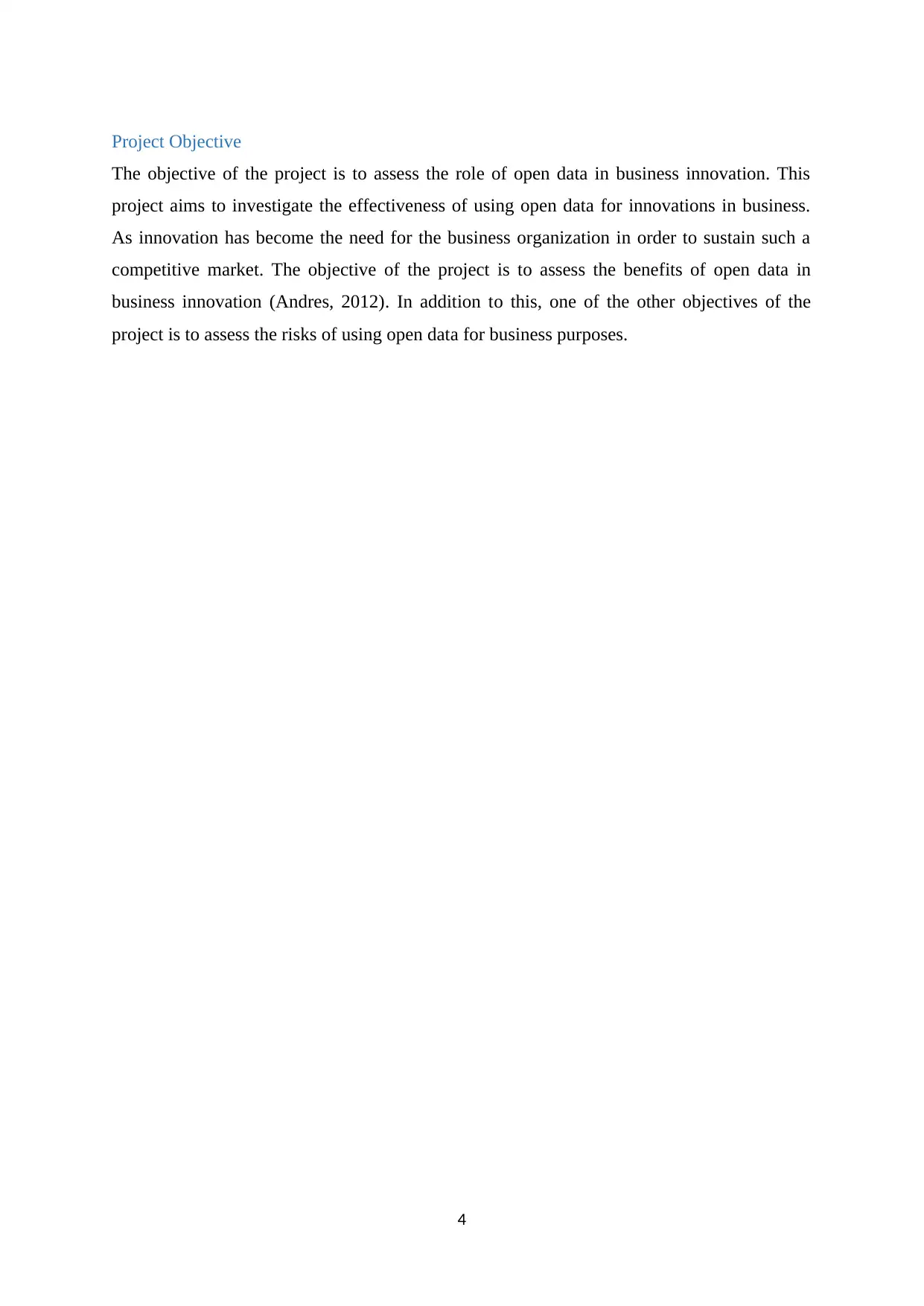
Project Objective
The objective of the project is to assess the role of open data in business innovation. This
project aims to investigate the effectiveness of using open data for innovations in business.
As innovation has become the need for the business organization in order to sustain such a
competitive market. The objective of the project is to assess the benefits of open data in
business innovation (Andres, 2012). In addition to this, one of the other objectives of the
project is to assess the risks of using open data for business purposes.
4
The objective of the project is to assess the role of open data in business innovation. This
project aims to investigate the effectiveness of using open data for innovations in business.
As innovation has become the need for the business organization in order to sustain such a
competitive market. The objective of the project is to assess the benefits of open data in
business innovation (Andres, 2012). In addition to this, one of the other objectives of the
project is to assess the risks of using open data for business purposes.
4
Paraphrase This Document
Need a fresh take? Get an instant paraphrase of this document with our AI Paraphraser
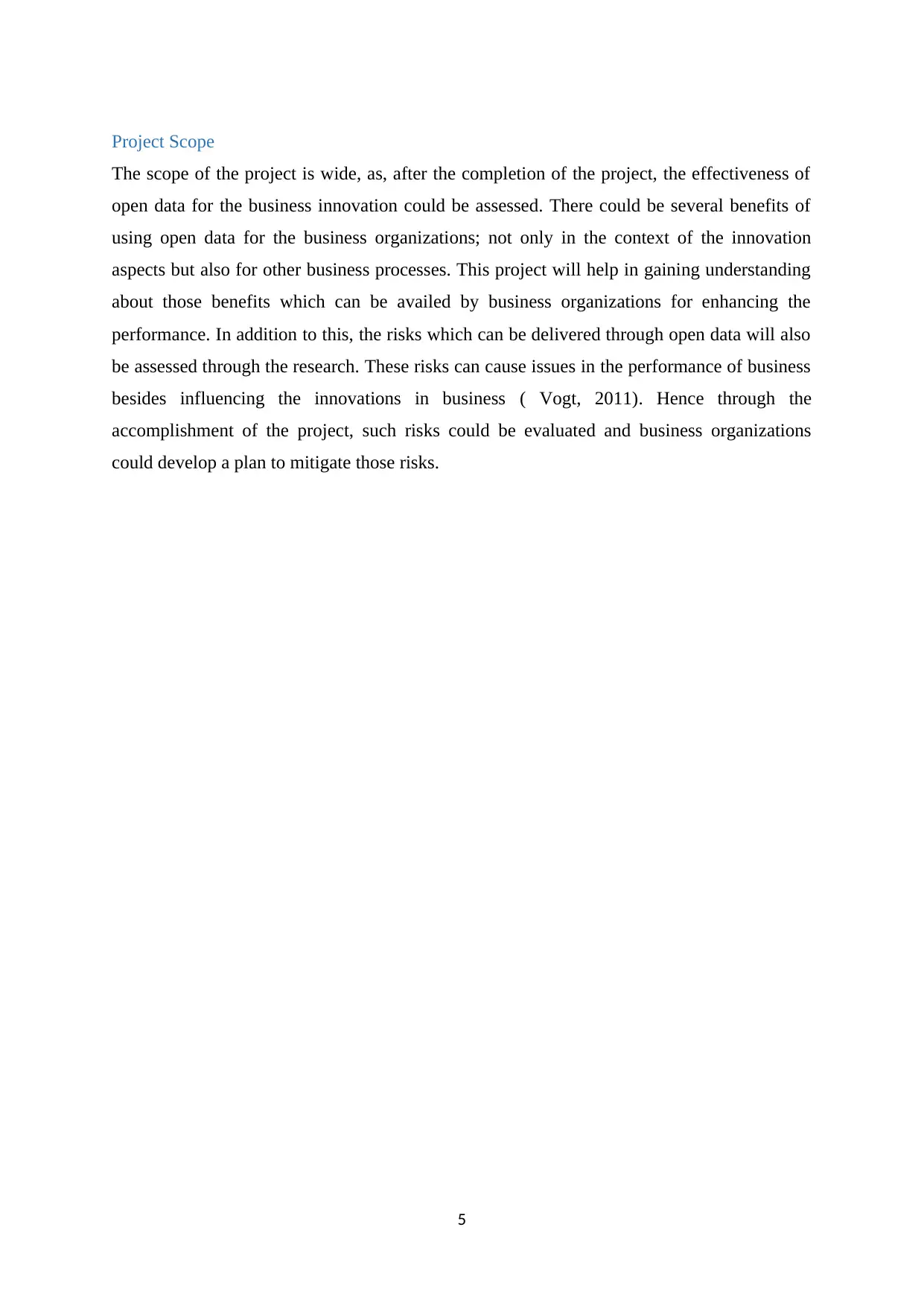
Project Scope
The scope of the project is wide, as, after the completion of the project, the effectiveness of
open data for the business innovation could be assessed. There could be several benefits of
using open data for the business organizations; not only in the context of the innovation
aspects but also for other business processes. This project will help in gaining understanding
about those benefits which can be availed by business organizations for enhancing the
performance. In addition to this, the risks which can be delivered through open data will also
be assessed through the research. These risks can cause issues in the performance of business
besides influencing the innovations in business ( Vogt, 2011). Hence through the
accomplishment of the project, such risks could be evaluated and business organizations
could develop a plan to mitigate those risks.
5
The scope of the project is wide, as, after the completion of the project, the effectiveness of
open data for the business innovation could be assessed. There could be several benefits of
using open data for the business organizations; not only in the context of the innovation
aspects but also for other business processes. This project will help in gaining understanding
about those benefits which can be availed by business organizations for enhancing the
performance. In addition to this, the risks which can be delivered through open data will also
be assessed through the research. These risks can cause issues in the performance of business
besides influencing the innovations in business ( Vogt, 2011). Hence through the
accomplishment of the project, such risks could be evaluated and business organizations
could develop a plan to mitigate those risks.
5
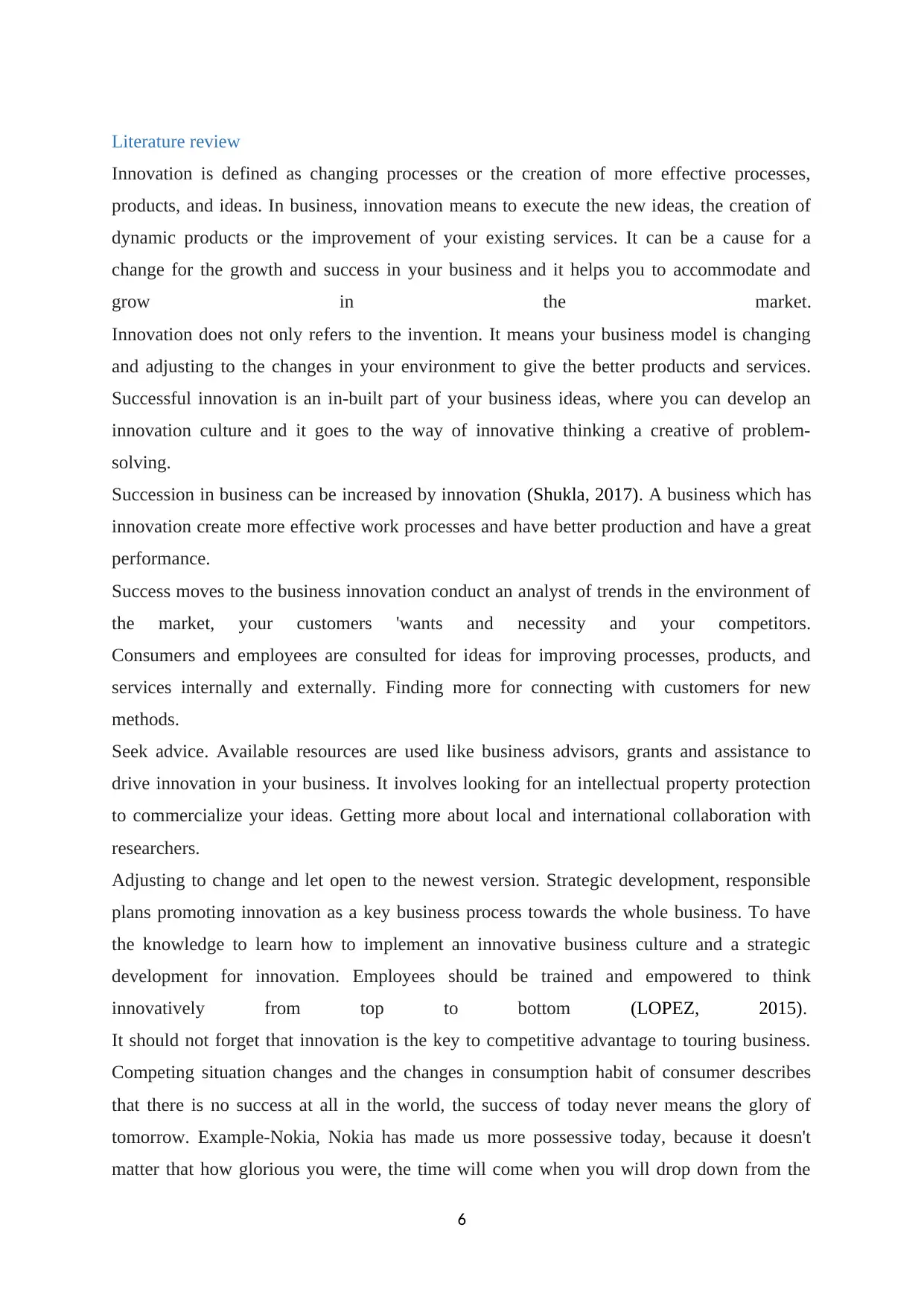
Literature review
Innovation is defined as changing processes or the creation of more effective processes,
products, and ideas. In business, innovation means to execute the new ideas, the creation of
dynamic products or the improvement of your existing services. It can be a cause for a
change for the growth and success in your business and it helps you to accommodate and
grow in the market.
Innovation does not only refers to the invention. It means your business model is changing
and adjusting to the changes in your environment to give the better products and services.
Successful innovation is an in-built part of your business ideas, where you can develop an
innovation culture and it goes to the way of innovative thinking a creative of problem-
solving.
Succession in business can be increased by innovation (Shukla, 2017). A business which has
innovation create more effective work processes and have better production and have a great
performance.
Success moves to the business innovation conduct an analyst of trends in the environment of
the market, your customers 'wants and necessity and your competitors.
Consumers and employees are consulted for ideas for improving processes, products, and
services internally and externally. Finding more for connecting with customers for new
methods.
Seek advice. Available resources are used like business advisors, grants and assistance to
drive innovation in your business. It involves looking for an intellectual property protection
to commercialize your ideas. Getting more about local and international collaboration with
researchers.
Adjusting to change and let open to the newest version. Strategic development, responsible
plans promoting innovation as a key business process towards the whole business. To have
the knowledge to learn how to implement an innovative business culture and a strategic
development for innovation. Employees should be trained and empowered to think
innovatively from top to bottom (LOPEZ, 2015).
It should not forget that innovation is the key to competitive advantage to touring business.
Competing situation changes and the changes in consumption habit of consumer describes
that there is no success at all in the world, the success of today never means the glory of
tomorrow. Example-Nokia, Nokia has made us more possessive today, because it doesn't
matter that how glorious you were, the time will come when you will drop down from the
6
Innovation is defined as changing processes or the creation of more effective processes,
products, and ideas. In business, innovation means to execute the new ideas, the creation of
dynamic products or the improvement of your existing services. It can be a cause for a
change for the growth and success in your business and it helps you to accommodate and
grow in the market.
Innovation does not only refers to the invention. It means your business model is changing
and adjusting to the changes in your environment to give the better products and services.
Successful innovation is an in-built part of your business ideas, where you can develop an
innovation culture and it goes to the way of innovative thinking a creative of problem-
solving.
Succession in business can be increased by innovation (Shukla, 2017). A business which has
innovation create more effective work processes and have better production and have a great
performance.
Success moves to the business innovation conduct an analyst of trends in the environment of
the market, your customers 'wants and necessity and your competitors.
Consumers and employees are consulted for ideas for improving processes, products, and
services internally and externally. Finding more for connecting with customers for new
methods.
Seek advice. Available resources are used like business advisors, grants and assistance to
drive innovation in your business. It involves looking for an intellectual property protection
to commercialize your ideas. Getting more about local and international collaboration with
researchers.
Adjusting to change and let open to the newest version. Strategic development, responsible
plans promoting innovation as a key business process towards the whole business. To have
the knowledge to learn how to implement an innovative business culture and a strategic
development for innovation. Employees should be trained and empowered to think
innovatively from top to bottom (LOPEZ, 2015).
It should not forget that innovation is the key to competitive advantage to touring business.
Competing situation changes and the changes in consumption habit of consumer describes
that there is no success at all in the world, the success of today never means the glory of
tomorrow. Example-Nokia, Nokia has made us more possessive today, because it doesn't
matter that how glorious you were, the time will come when you will drop down from the
6
⊘ This is a preview!⊘
Do you want full access?
Subscribe today to unlock all pages.

Trusted by 1+ million students worldwide
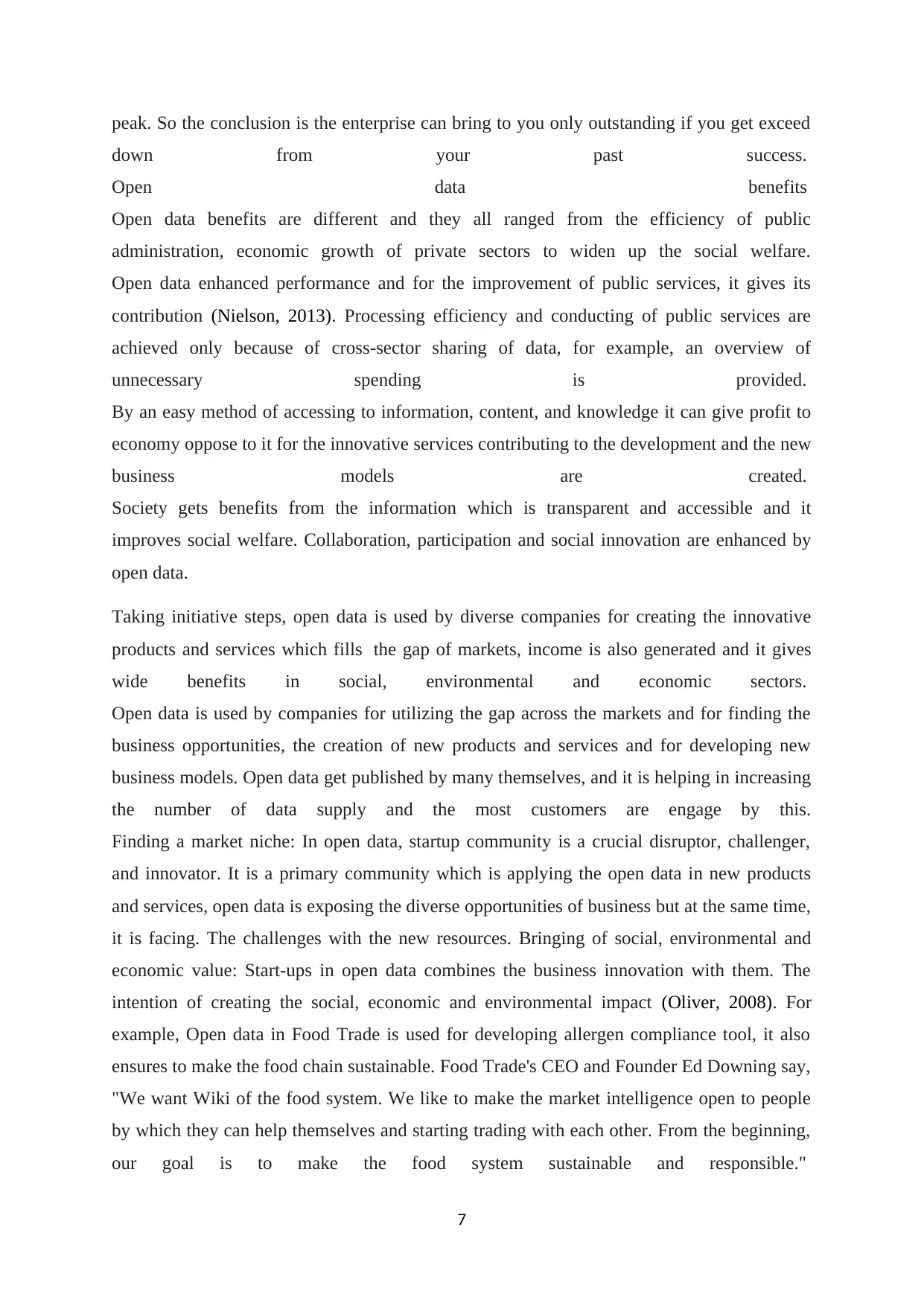
peak. So the conclusion is the enterprise can bring to you only outstanding if you get exceed
down from your past success.
Open data benefits
Open data benefits are different and they all ranged from the efficiency of public
administration, economic growth of private sectors to widen up the social welfare.
Open data enhanced performance and for the improvement of public services, it gives its
contribution (Nielson, 2013). Processing efficiency and conducting of public services are
achieved only because of cross-sector sharing of data, for example, an overview of
unnecessary spending is provided.
By an easy method of accessing to information, content, and knowledge it can give profit to
economy oppose to it for the innovative services contributing to the development and the new
business models are created.
Society gets benefits from the information which is transparent and accessible and it
improves social welfare. Collaboration, participation and social innovation are enhanced by
open data.
Taking initiative steps, open data is used by diverse companies for creating the innovative
products and services which fills the gap of markets, income is also generated and it gives
wide benefits in social, environmental and economic sectors.
Open data is used by companies for utilizing the gap across the markets and for finding the
business opportunities, the creation of new products and services and for developing new
business models. Open data get published by many themselves, and it is helping in increasing
the number of data supply and the most customers are engage by this.
Finding a market niche: In open data, startup community is a crucial disruptor, challenger,
and innovator. It is a primary community which is applying the open data in new products
and services, open data is exposing the diverse opportunities of business but at the same time,
it is facing. The challenges with the new resources. Bringing of social, environmental and
economic value: Start-ups in open data combines the business innovation with them. The
intention of creating the social, economic and environmental impact (Oliver, 2008). For
example, Open data in Food Trade is used for developing allergen compliance tool, it also
ensures to make the food chain sustainable. Food Trade's CEO and Founder Ed Downing say,
"We want Wiki of the food system. We like to make the market intelligence open to people
by which they can help themselves and starting trading with each other. From the beginning,
our goal is to make the food system sustainable and responsible."
7
down from your past success.
Open data benefits
Open data benefits are different and they all ranged from the efficiency of public
administration, economic growth of private sectors to widen up the social welfare.
Open data enhanced performance and for the improvement of public services, it gives its
contribution (Nielson, 2013). Processing efficiency and conducting of public services are
achieved only because of cross-sector sharing of data, for example, an overview of
unnecessary spending is provided.
By an easy method of accessing to information, content, and knowledge it can give profit to
economy oppose to it for the innovative services contributing to the development and the new
business models are created.
Society gets benefits from the information which is transparent and accessible and it
improves social welfare. Collaboration, participation and social innovation are enhanced by
open data.
Taking initiative steps, open data is used by diverse companies for creating the innovative
products and services which fills the gap of markets, income is also generated and it gives
wide benefits in social, environmental and economic sectors.
Open data is used by companies for utilizing the gap across the markets and for finding the
business opportunities, the creation of new products and services and for developing new
business models. Open data get published by many themselves, and it is helping in increasing
the number of data supply and the most customers are engage by this.
Finding a market niche: In open data, startup community is a crucial disruptor, challenger,
and innovator. It is a primary community which is applying the open data in new products
and services, open data is exposing the diverse opportunities of business but at the same time,
it is facing. The challenges with the new resources. Bringing of social, environmental and
economic value: Start-ups in open data combines the business innovation with them. The
intention of creating the social, economic and environmental impact (Oliver, 2008). For
example, Open data in Food Trade is used for developing allergen compliance tool, it also
ensures to make the food chain sustainable. Food Trade's CEO and Founder Ed Downing say,
"We want Wiki of the food system. We like to make the market intelligence open to people
by which they can help themselves and starting trading with each other. From the beginning,
our goal is to make the food system sustainable and responsible."
7
Paraphrase This Document
Need a fresh take? Get an instant paraphrase of this document with our AI Paraphraser
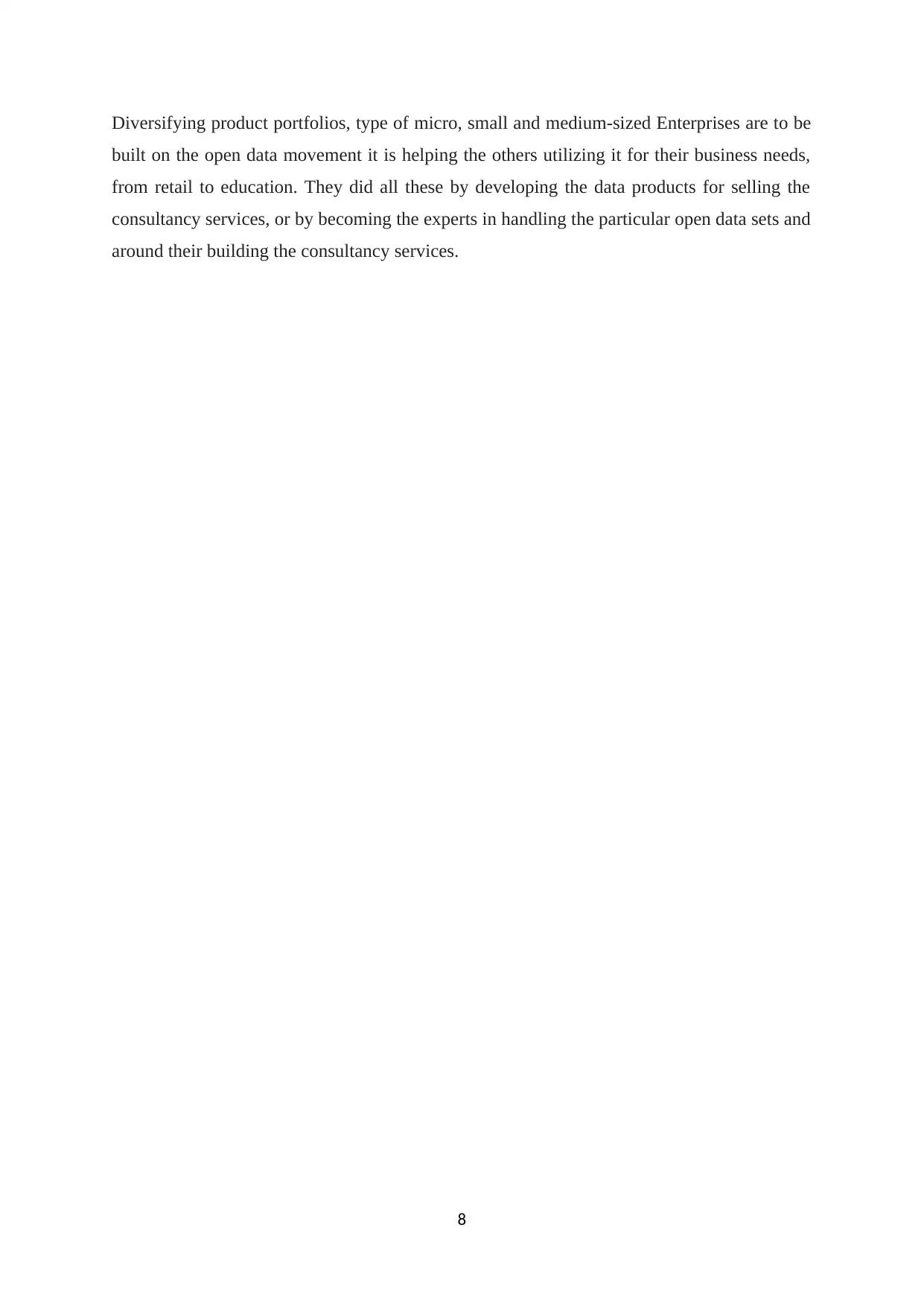
Diversifying product portfolios, type of micro, small and medium-sized Enterprises are to be
built on the open data movement it is helping the others utilizing it for their business needs,
from retail to education. They did all these by developing the data products for selling the
consultancy services, or by becoming the experts in handling the particular open data sets and
around their building the consultancy services.
8
built on the open data movement it is helping the others utilizing it for their business needs,
from retail to education. They did all these by developing the data products for selling the
consultancy services, or by becoming the experts in handling the particular open data sets and
around their building the consultancy services.
8
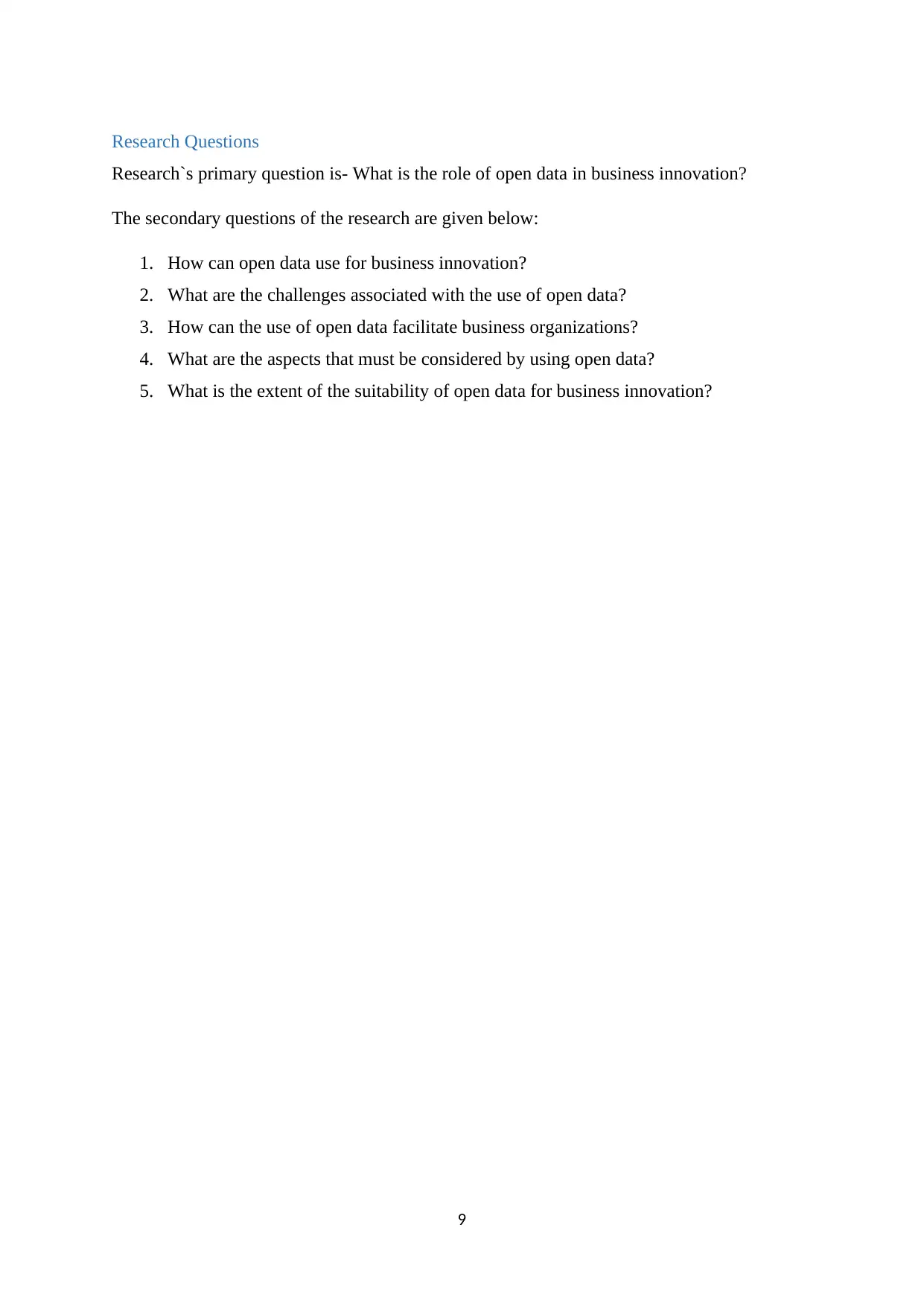
Research Questions
Research`s primary question is- What is the role of open data in business innovation?
The secondary questions of the research are given below:
1. How can open data use for business innovation?
2. What are the challenges associated with the use of open data?
3. How can the use of open data facilitate business organizations?
4. What are the aspects that must be considered by using open data?
5. What is the extent of the suitability of open data for business innovation?
9
Research`s primary question is- What is the role of open data in business innovation?
The secondary questions of the research are given below:
1. How can open data use for business innovation?
2. What are the challenges associated with the use of open data?
3. How can the use of open data facilitate business organizations?
4. What are the aspects that must be considered by using open data?
5. What is the extent of the suitability of open data for business innovation?
9
⊘ This is a preview!⊘
Do you want full access?
Subscribe today to unlock all pages.

Trusted by 1+ million students worldwide
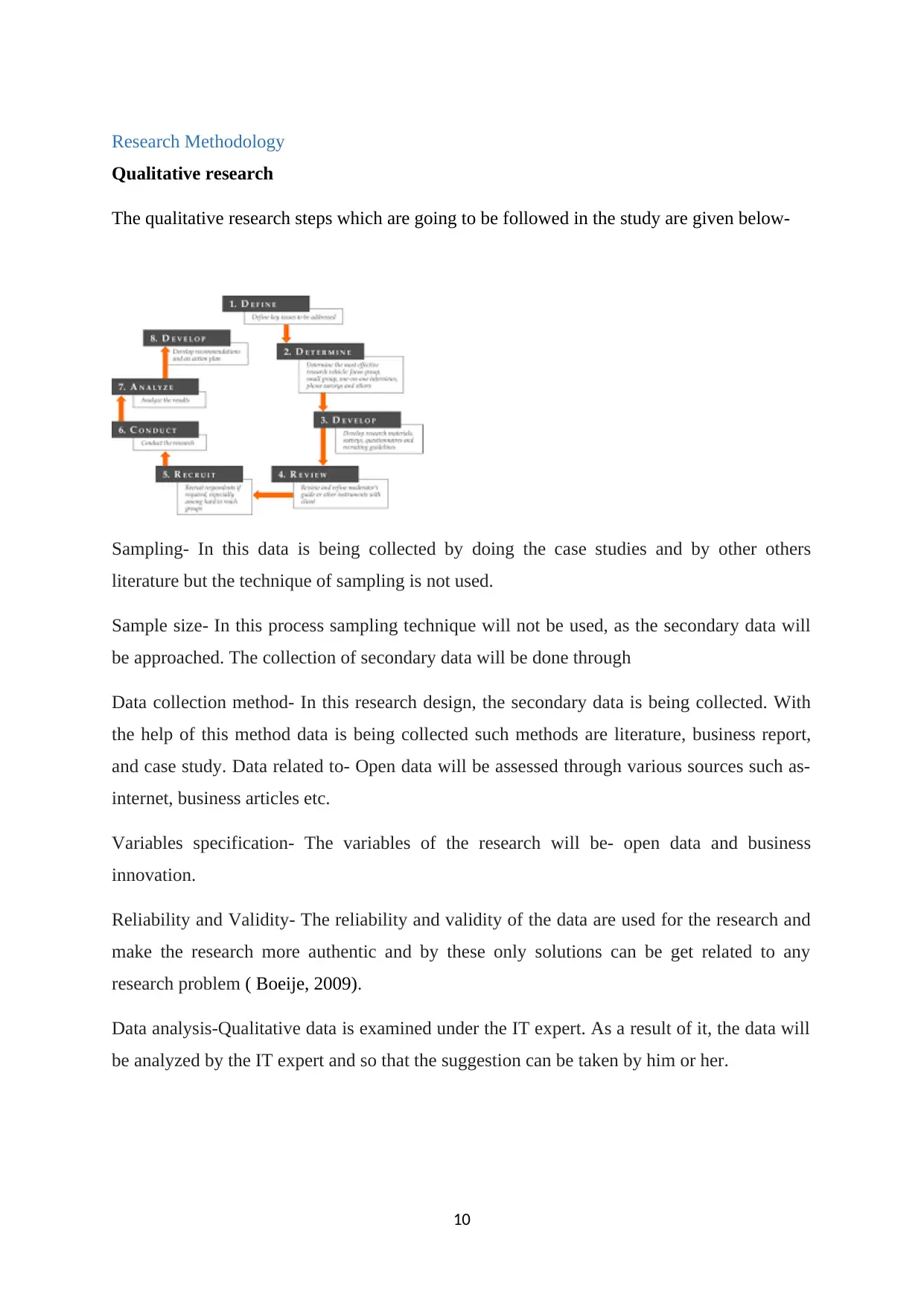
Research Methodology
Qualitative research
The qualitative research steps which are going to be followed in the study are given below-
Sampling- In this data is being collected by doing the case studies and by other others
literature but the technique of sampling is not used.
Sample size- In this process sampling technique will not be used, as the secondary data will
be approached. The collection of secondary data will be done through
Data collection method- In this research design, the secondary data is being collected. With
the help of this method data is being collected such methods are literature, business report,
and case study. Data related to- Open data will be assessed through various sources such as-
internet, business articles etc.
Variables specification- The variables of the research will be- open data and business
innovation.
Reliability and Validity- The reliability and validity of the data are used for the research and
make the research more authentic and by these only solutions can be get related to any
research problem ( Boeije, 2009).
Data analysis-Qualitative data is examined under the IT expert. As a result of it, the data will
be analyzed by the IT expert and so that the suggestion can be taken by him or her.
10
Qualitative research
The qualitative research steps which are going to be followed in the study are given below-
Sampling- In this data is being collected by doing the case studies and by other others
literature but the technique of sampling is not used.
Sample size- In this process sampling technique will not be used, as the secondary data will
be approached. The collection of secondary data will be done through
Data collection method- In this research design, the secondary data is being collected. With
the help of this method data is being collected such methods are literature, business report,
and case study. Data related to- Open data will be assessed through various sources such as-
internet, business articles etc.
Variables specification- The variables of the research will be- open data and business
innovation.
Reliability and Validity- The reliability and validity of the data are used for the research and
make the research more authentic and by these only solutions can be get related to any
research problem ( Boeije, 2009).
Data analysis-Qualitative data is examined under the IT expert. As a result of it, the data will
be analyzed by the IT expert and so that the suggestion can be taken by him or her.
10
Paraphrase This Document
Need a fresh take? Get an instant paraphrase of this document with our AI Paraphraser
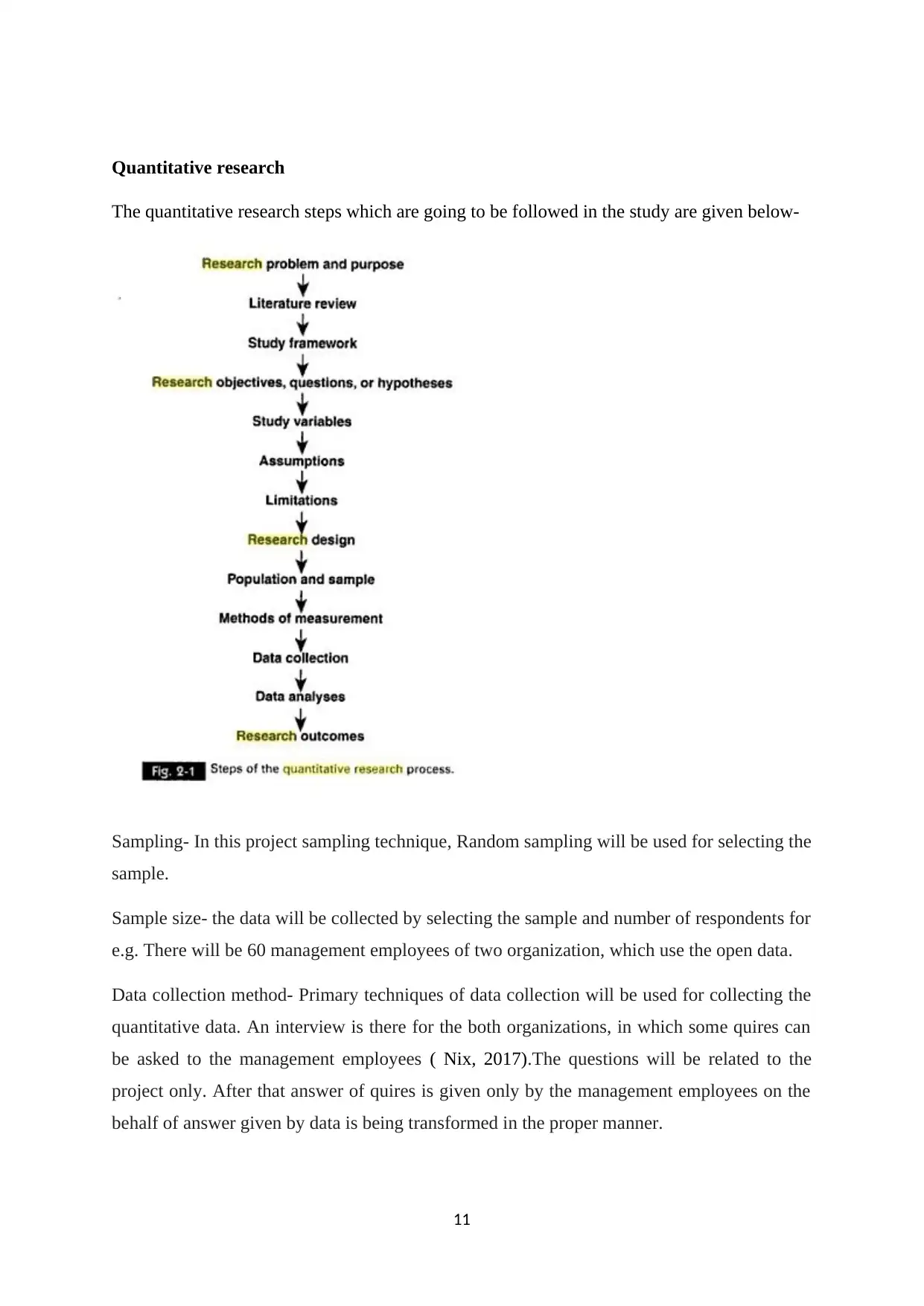
Quantitative research
The quantitative research steps which are going to be followed in the study are given below-
Sampling- In this project sampling technique, Random sampling will be used for selecting the
sample.
Sample size- the data will be collected by selecting the sample and number of respondents for
e.g. There will be 60 management employees of two organization, which use the open data.
Data collection method- Primary techniques of data collection will be used for collecting the
quantitative data. An interview is there for the both organizations, in which some quires can
be asked to the management employees ( Nix, 2017).The questions will be related to the
project only. After that answer of quires is given only by the management employees on the
behalf of answer given by data is being transformed in the proper manner.
11
The quantitative research steps which are going to be followed in the study are given below-
Sampling- In this project sampling technique, Random sampling will be used for selecting the
sample.
Sample size- the data will be collected by selecting the sample and number of respondents for
e.g. There will be 60 management employees of two organization, which use the open data.
Data collection method- Primary techniques of data collection will be used for collecting the
quantitative data. An interview is there for the both organizations, in which some quires can
be asked to the management employees ( Nix, 2017).The questions will be related to the
project only. After that answer of quires is given only by the management employees on the
behalf of answer given by data is being transformed in the proper manner.
11
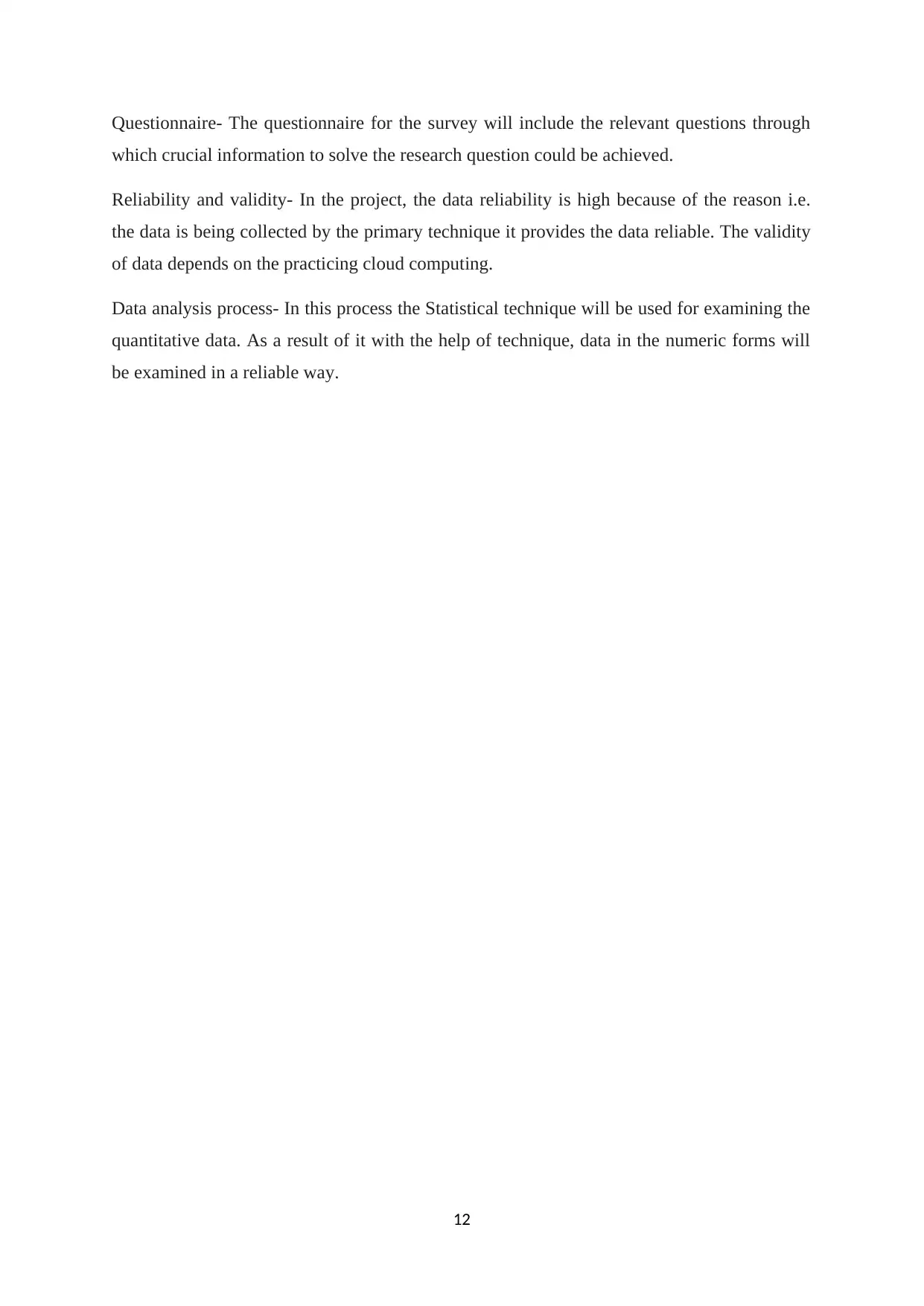
Questionnaire- The questionnaire for the survey will include the relevant questions through
which crucial information to solve the research question could be achieved.
Reliability and validity- In the project, the data reliability is high because of the reason i.e.
the data is being collected by the primary technique it provides the data reliable. The validity
of data depends on the practicing cloud computing.
Data analysis process- In this process the Statistical technique will be used for examining the
quantitative data. As a result of it with the help of technique, data in the numeric forms will
be examined in a reliable way.
12
which crucial information to solve the research question could be achieved.
Reliability and validity- In the project, the data reliability is high because of the reason i.e.
the data is being collected by the primary technique it provides the data reliable. The validity
of data depends on the practicing cloud computing.
Data analysis process- In this process the Statistical technique will be used for examining the
quantitative data. As a result of it with the help of technique, data in the numeric forms will
be examined in a reliable way.
12
⊘ This is a preview!⊘
Do you want full access?
Subscribe today to unlock all pages.

Trusted by 1+ million students worldwide
1 out of 17
Related Documents
Your All-in-One AI-Powered Toolkit for Academic Success.
+13062052269
info@desklib.com
Available 24*7 on WhatsApp / Email
![[object Object]](/_next/static/media/star-bottom.7253800d.svg)
Unlock your academic potential
Copyright © 2020–2025 A2Z Services. All Rights Reserved. Developed and managed by ZUCOL.




